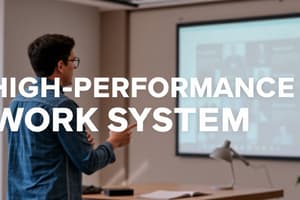Podcast
Questions and Answers
Which of the following is a characteristic of an 'Enterprising' personality type?
Which of the following is a characteristic of an 'Enterprising' personality type?
- Enjoys creative activities like art and music
- Values helping people and solving social problems
- Prefers working with numbers and records
- Likes to lead, persuade, and sell (correct)
Individuals with a 'Social' personality type generally prefer to work with tools and machines.
Individuals with a 'Social' personality type generally prefer to work with tools and machines.
False (B)
What is the definition of learning, as described in the content?
What is the definition of learning, as described in the content?
A permanent change in behavior or attitude brought about by education and training.
Someone with a 'Conventional' personality likes to work in a set, ________ way.
Someone with a 'Conventional' personality likes to work in a set, ________ way.
Which of the following is NOT a characteristic of an 'Artistic' personality type?
Which of the following is NOT a characteristic of an 'Artistic' personality type?
Match the personality type with their core value:
Match the personality type with their core value:
A person with an 'Enterprising' personality would likely avoid leadership roles.
A person with an 'Enterprising' personality would likely avoid leadership roles.
Which of the following is a skill that an individual with a 'Social' personality type likely possesses?
Which of the following is a skill that an individual with a 'Social' personality type likely possesses?
Which of the following is NOT a key function of an HRIMS?
Which of the following is NOT a key function of an HRIMS?
A sophisticated HRIMS system cannot interface directly with payroll providers.
A sophisticated HRIMS system cannot interface directly with payroll providers.
What is the term used to describe work-related experiences, roles, and achievements that contribute to one's professional growth and personal fulfillment?
What is the term used to describe work-related experiences, roles, and achievements that contribute to one's professional growth and personal fulfillment?
_________ lists, union membership, grievances, and resolutions of grievances are all part of labor relations.
_________ lists, union membership, grievances, and resolutions of grievances are all part of labor relations.
Which of these is a factor that influences career choices?
Which of these is a factor that influences career choices?
An HRIMS primarily helps in managing financial data rather than human resources.
An HRIMS primarily helps in managing financial data rather than human resources.
Besides salary and wages, what is another type of information commonly handled in an HR department for payroll interfacing?
Besides salary and wages, what is another type of information commonly handled in an HR department for payroll interfacing?
Match the terms with their descriptions:
Match the terms with their descriptions:
Which of the following best describes 'development' according to the text?
Which of the following best describes 'development' according to the text?
Learning and Development (L&D) efforts are solely focused on individual employee performance.
Learning and Development (L&D) efforts are solely focused on individual employee performance.
What is the primary goal of Strategic Human Resource Management (SHRM)?
What is the primary goal of Strategic Human Resource Management (SHRM)?
The application of acquired knowledge from learning, which reflects personal growth and progress is referred to as ______.
The application of acquired knowledge from learning, which reflects personal growth and progress is referred to as ______.
Which of the following is NOT a typical component of Learning and Development efforts?
Which of the following is NOT a typical component of Learning and Development efforts?
Human Resource Management (HRM) prioritizes future skill development over current needs.
Human Resource Management (HRM) prioritizes future skill development over current needs.
Match the following terms with their descriptions:
Match the following terms with their descriptions:
What is necessary for effective L&D, aside from training programs and needs assessment?
What is necessary for effective L&D, aside from training programs and needs assessment?
What is the primary purpose of measuring learning and development effectiveness?
What is the primary purpose of measuring learning and development effectiveness?
A corporate culture has no impact on training and development programs.
A corporate culture has no impact on training and development programs.
What metric measures the percentage of employees who successfully completed a training course?
What metric measures the percentage of employees who successfully completed a training course?
Gaining feedback from employees about their perceived training experience is known as __________.
Gaining feedback from employees about their perceived training experience is known as __________.
Why is a learning corporate culture important?
Why is a learning corporate culture important?
Measuring learning and development is only for the benefit of the organization, not the employees.
Measuring learning and development is only for the benefit of the organization, not the employees.
What does the measurement of training effectiveness help employees to see?
What does the measurement of training effectiveness help employees to see?
What is the primary focus of assessing knowledge or skills in the workplace?
What is the primary focus of assessing knowledge or skills in the workplace?
Post-training evaluations only measure the immediate feedback from participants.
Post-training evaluations only measure the immediate feedback from participants.
What does the Kirkpatrick Model primarily measure?
What does the Kirkpatrick Model primarily measure?
The _____ ROI Model calculates the financial return on investment by comparing training benefits to its costs.
The _____ ROI Model calculates the financial return on investment by comparing training benefits to its costs.
Match the following components of the Kirkpatrick Model with their definitions:
Match the following components of the Kirkpatrick Model with their definitions:
Which of the following is NOT a focus area for post-training performance evaluations?
Which of the following is NOT a focus area for post-training performance evaluations?
Employee engagement after training reflects whether they feel motivated and informed.
Employee engagement after training reflects whether they feel motivated and informed.
What is one way to measure the impact of training on revenue growth?
What is one way to measure the impact of training on revenue growth?
What should an effective Learning and Development (L&D) plan be aligned with?
What should an effective Learning and Development (L&D) plan be aligned with?
The leadership team is not necessary for planning an effective L&D plan.
The leadership team is not necessary for planning an effective L&D plan.
What is one method to identify the organization’s needs prior to training?
What is one method to identify the organization’s needs prior to training?
An effective L&D plan must have _____ objectives to monitor its progress.
An effective L&D plan must have _____ objectives to monitor its progress.
Which of the following is NOT an example of a measurable objective for an L&D plan?
Which of the following is NOT an example of a measurable objective for an L&D plan?
Engaging learning methods are optional for an effective L&D plan.
Engaging learning methods are optional for an effective L&D plan.
Match the following elements of an effective L&D plan with their purposes:
Match the following elements of an effective L&D plan with their purposes:
List one performance issue that could be addressed by an L&D plan.
List one performance issue that could be addressed by an L&D plan.
Flashcards
Development
Development
The use of acquired knowledge to enhance skills and gain new ones, leading to personal growth and progress.
Learning and Development (L&D)
Learning and Development (L&D)
The process of improving employees' knowledge, skills, and abilities through various methods.
Needs Assessment
Needs Assessment
A systematic approach to identifying and addressing training needs within an organization.
Training Programs
Training Programs
Signup and view all the flashcards
Leadership Development
Leadership Development
Signup and view all the flashcards
Career Pathing and Succession Planning
Career Pathing and Succession Planning
Signup and view all the flashcards
Performance Management
Performance Management
Signup and view all the flashcards
Technology Integration
Technology Integration
Signup and view all the flashcards
Seniority List
Seniority List
Signup and view all the flashcards
Grievance Resolution
Grievance Resolution
Signup and view all the flashcards
HRIMS
HRIMS
Signup and view all the flashcards
Payroll Interface
Payroll Interface
Signup and view all the flashcards
Career
Career
Signup and view all the flashcards
Factors Influencing Career Choices?
Factors Influencing Career Choices?
Signup and view all the flashcards
Job Market Demand
Job Market Demand
Signup and view all the flashcards
Personal Circumstances
Personal Circumstances
Signup and view all the flashcards
L&D Program Effectiveness Measurement
L&D Program Effectiveness Measurement
Signup and view all the flashcards
Learning Satisfaction
Learning Satisfaction
Signup and view all the flashcards
Training Completion Rate
Training Completion Rate
Signup and view all the flashcards
Training Effectiveness
Training Effectiveness
Signup and view all the flashcards
Why is L&D Program Measurement Crucial?
Why is L&D Program Measurement Crucial?
Signup and view all the flashcards
Learning Corporate Culture
Learning Corporate Culture
Signup and view all the flashcards
Metrics to Assess L&D Success
Metrics to Assess L&D Success
Signup and view all the flashcards
Benefits of Effective L&D Programs
Benefits of Effective L&D Programs
Signup and view all the flashcards
Alignment with Business Needs
Alignment with Business Needs
Signup and view all the flashcards
Catered to Employee Needs
Catered to Employee Needs
Signup and view all the flashcards
Clear Objectives
Clear Objectives
Signup and view all the flashcards
Employment of Methods and Tools
Employment of Methods and Tools
Signup and view all the flashcards
Leadership Involvement
Leadership Involvement
Signup and view all the flashcards
Solving Complex Issues
Solving Complex Issues
Signup and view all the flashcards
Effective L&D Plan
Effective L&D Plan
Signup and view all the flashcards
Taking the Lead
Taking the Lead
Signup and view all the flashcards
Artistic Personality
Artistic Personality
Signup and view all the flashcards
Social Personality
Social Personality
Signup and view all the flashcards
Enterprising Personality
Enterprising Personality
Signup and view all the flashcards
Conventional Personality
Conventional Personality
Signup and view all the flashcards
Learning
Learning
Signup and view all the flashcards
Learning: An Acquisition Process
Learning: An Acquisition Process
Signup and view all the flashcards
Learning: A Change in Behavior or Attitude
Learning: A Change in Behavior or Attitude
Signup and view all the flashcards
Learning as Transformation
Learning as Transformation
Signup and view all the flashcards
Reaction Evaluation
Reaction Evaluation
Signup and view all the flashcards
Learning Evaluation
Learning Evaluation
Signup and view all the flashcards
Behavior Evaluation
Behavior Evaluation
Signup and view all the flashcards
Results Evaluation
Results Evaluation
Signup and view all the flashcards
Kirkpatrick Model
Kirkpatrick Model
Signup and view all the flashcards
Phillip's ROI Model
Phillip's ROI Model
Signup and view all the flashcards
Post-training Performance Evaluation
Post-training Performance Evaluation
Signup and view all the flashcards
Training ROI
Training ROI
Signup and view all the flashcards
Study Notes
Human Resource Management Systems
- HR systems integrate HR and IT through software
- Allow HR activities to occur electronically
- Help companies invest in the future and succeed
- Customizable to company-specific needs, remaining relevant
- HRIMS needs: identifying manpower needs, resources, equal employment opportunities, and training needs
- Data sources include departmental data (e.g., finance, marketing), surveys, and external sources (outsourcing or external warehouses)
- HRIMS types include supporting workforce planning, labor negotiations, and specialized HRIMS software for various computer sizes
HRIMS Structure
- Composite of databases, applications, and hardware for managing and presenting HR data
- Also includes people, policies, procedures, and data needed to manage HR functions
- Composed of several subsystems
Employee Administration
- Tracks information like hire date, name, address, phone, email, gender, salary, emergency contacts, department, location, and employment status
Recruitment
- Includes position name, number, department, approval status, and full/part-time status
Time and Attendance
- Calculates vacation time, absence, termination dates, and late entries
Training and Development
- Data on employee skills, competencies, training courses, costs, activities, and career planning
Pension Administration
- Information on pension plan design, employee and company contributions
Performance Evaluation
- Performance ratings, review dates, appraisal types, comments, and performance objectives
Compensation and Benefits
- Details of compensation and benefit plans and policies
Health and Safety
- Information on accidents, accident types, health complaints, and resolutions
Labor Relations
- Information on seniority lists, union membership, grievances, and their resolutions
Payroll Interface
- Provides information on salary, wages, and benefits for easier payroll processing. Sophisticated systems can directly interface with payroll providers.
Key Mechanisms of HRIMS
- Creates and maintains employee records
- Ensures compliance with legal requirements
- Forecasts and plans future HR needs
- Provides managers with information to manage knowledge and talent (career and succession planning)
- A system to align HR plans with organizational goals
- Assists management with decision-making through data analysis
Career Management and Development
- Career encompasses work experience, roles, achievements, professional growth, personal fulfillment, and a person's chosen vocation throughout their working life
- Factors influencing career choices include interests, skills, values, personality, education, experience, job market demand, personal circumstances etc.
- Career development refers to the interaction of psychological, sociological, economical, physical and chance factors shaping job/career sequences over a lifetime
- Career dynamics are influenced by diverse factors shaping career choices, trajectories, and satisfaction during one's working life.
- The evolving sequence of work experiences shapes careers over time including education, work, family, leisure activities and more
- Job definitions are sets of activities that a worker is expected to perform in a specific position with certain duties
- Occupations are job clusters with similar skills which may include jobs like photographer
Types of Careers
- Steady-state: a lifetime in a single position
- Linear: progressing through roles on a career ladder
- Spiral: evolving through different occupations using acquired skills
- Transitory: shifting between unrelated roles
Career Development Skills
- Skills involved in managing a career including career planning, strategizing, executing action plans, and evaluating progress.
Holland's Theory of Vocational Choice
- The theory stating that people perform best in professions that match their traits and personality characteristics
RIASEC
- A conceptualization that identifies occupations in which people are best suited based on six personality types: Realistic, Investigative, Artistic, Social, Enterprising, Conventional.
Factors Influencing Career Choices
- Includes interests, skills, values, personality, education, experience, job market demand, personal circumstances
Learning and Development
- Learning is a permanent behavior or attitude change attained through training or education
- Development involves applying knowledge and enhancing skills for future opportunities
- Learning and Development (L&D) improve employee knowledge, skills, and abilities (KSAs) which impacts individual and organizational performance.
- Development helps leaders solve problems. Leaders need skills for leadership challenges.
Why learning and development go together:
- Learning provides skills, development applies them in problem-solving.
HRM vs SHRM
- HRM focuses on operational training and development to improve employee performance
- SHRM links to long-term, organizational goals and emphasizes future skill development for innovation and succession planning.
Learning and Development Plan Effectiveness
- Aligns with business needs
- Tailored to employee needs through a needs assessment
- Clearly defined objectives
- Uses appropriate methods and tools
- Includes communication and engagement plans
- Utilizes metrics for tracking progress, return on investment, and overall effectiveness
- Includes a learning corporate culture
- Assesses success through relevant metrics including learning satisfaction, training completion rates, knowledge assessed, performance evaluations, training ROI, employee engagement and motivation, individual/team performance, staff retention, and revenue growth..
Kirkpatrick Model
- Measures training effectiveness through reaction, learning, behavior, and results. It helps in assessing the benefits gained by comparing costs with results.
HRIMS Video
- HRIS development steps:
- research (know requirements)
- planning and aligning
- defining and designing (identifying basic needs)
- configuring and testing
- training and communication
- deployment and sustainability (ensuring support systems are in place).
Studying That Suits You
Use AI to generate personalized quizzes and flashcards to suit your learning preferences.




